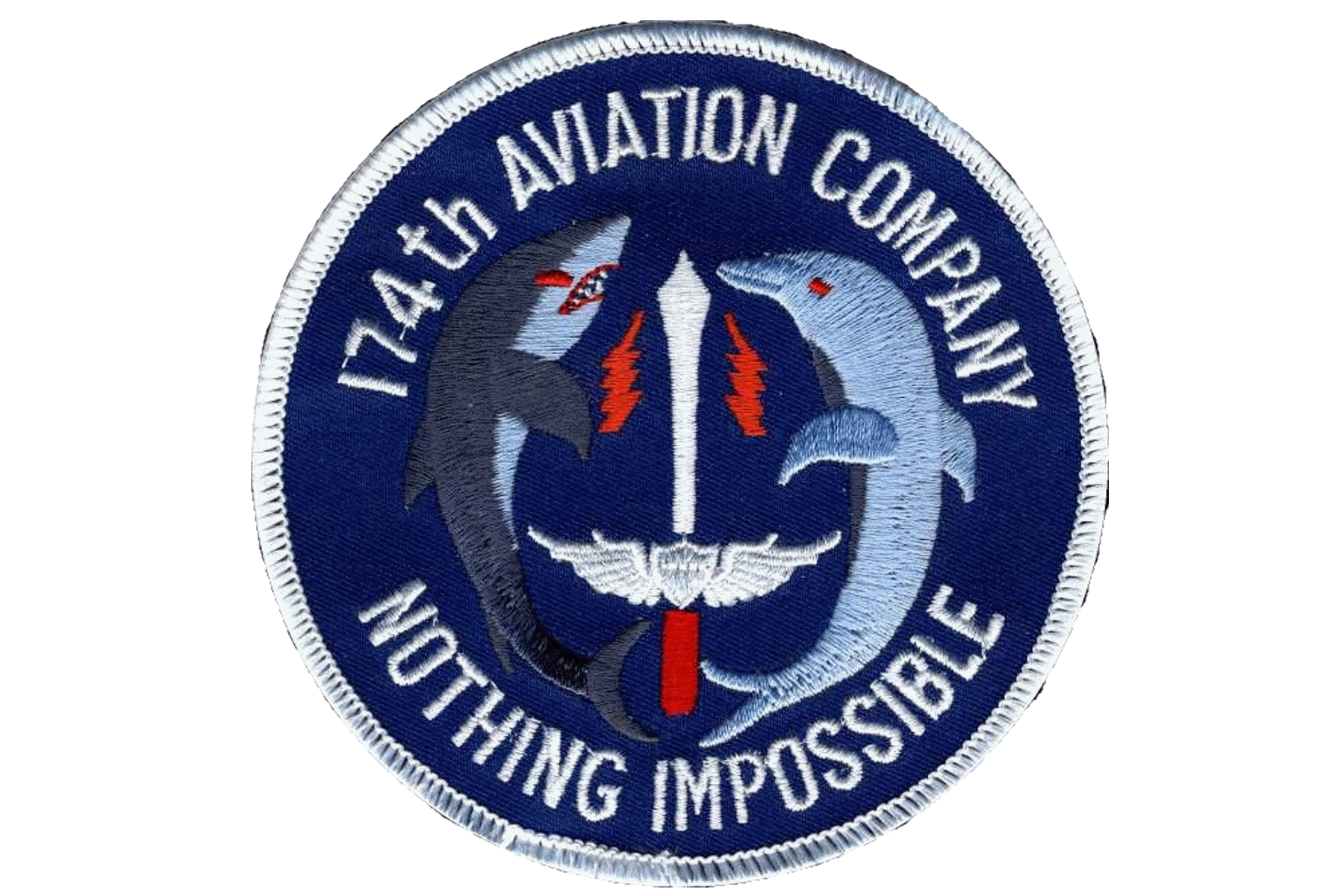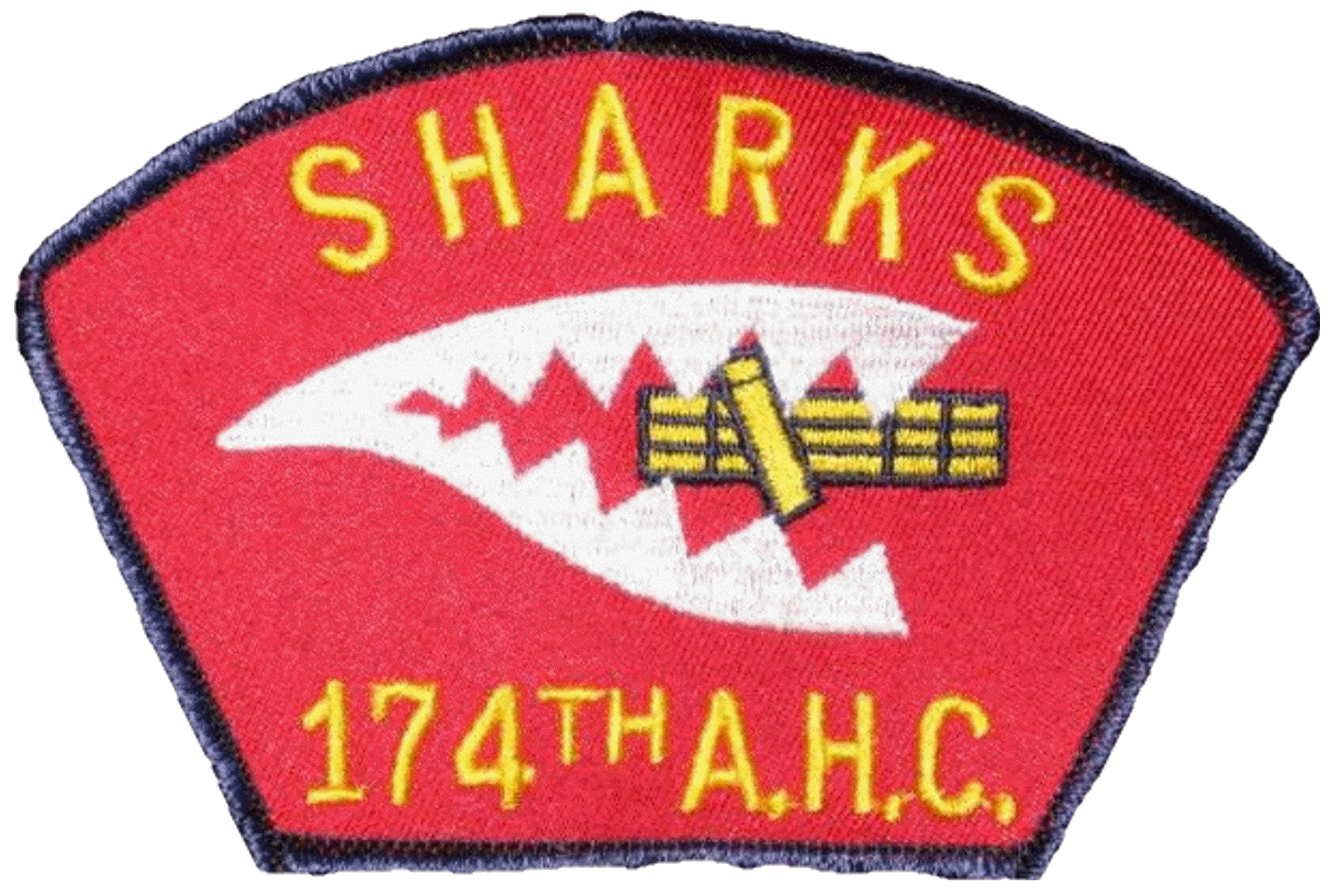174th Assault
Helicopter Company
DOLPHINS & SHARKS
 Click here
Click here  to write us at the website
to write us at the website 
"Mayday! Mayday! Witch Doctor 5
Is Down In The Trees West of A Luoi!"
On 5 March 1971, in Laos during Operation Lam Son 719, the 174th and 116th Assault
Helicopter Companies inserted the 1st ARVN Division (Army of South Vietnam) into LZ SOPHIA.
They met with heavy anti-aircraft fire. Three aircraft were shot down with two crews
successfully recovered. LT Butch Elliott and six other crew members were shot down and
stranded. LT Elliott was flying a 174th UH-1H (#68-16340) and went down at coordinates
XD547320. Repeated attempts at extraction by helicopter were unsuccessful.
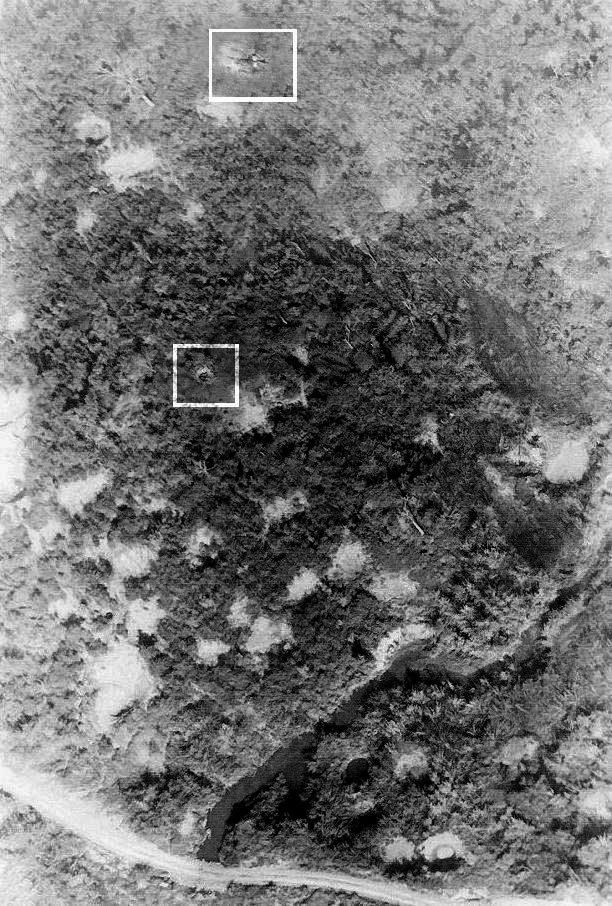
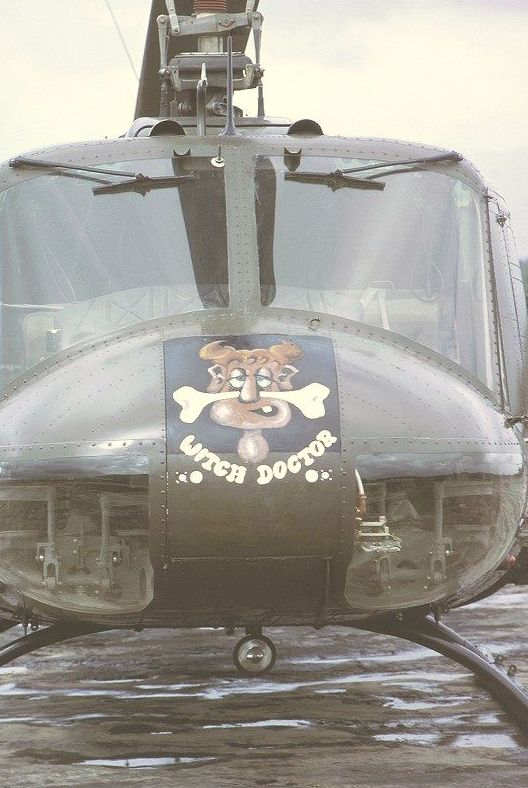
Above left is a very
rare
aerial shot of the "Witch Doctor"
downed on 5 March 1971 (Photo courtesy of the VHPA. Photographer unknown at this time. We
believe it was one of the FACs).
My annotated square at the north is of Elliott's aircraft (and is enlarged below left).
The square at the left-center of the photo is an abandoned NVA gun bunker where Elliott and
Crew held up for three days. My apologies, but this is actually my scan of a "several
generation"
scan.
We just can't replicate the enlargement here just right, where you can actually see the Crew
huddled in
the crater (enlarged below right/ very center). To the
right (south-east) of
the dark tree line were six NVA gun emplacements which brought down the "Witch Doctor" and
warded off rescue attempts.
"As we moved from place to place we could hear the bad guys approaching from the East"- Butch.
(Photo of the UH-1H #340 property of Robert Brackenhoff).
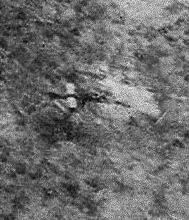
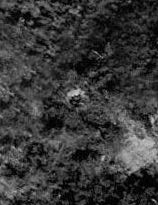
Butch Elliott recalls some details: |
I was Witch Doctor 5, the assistant maintenance officer for the 174th Assault Helicopter Company. CPT Greg Smith was the official MO (maintenance officer), but he flew with the Shark gunships a lot. The night before, during the briefing for this 60-ship combat assault to the west of FB (Fire Base) SOPHIA WEST, in Laos, we learned that the battalion plan called for three maintenance / rescue ships, and that our company would supply one. In addition to the regular crew of four, each aircraft would carry some tools plus a couple of maintenance specialists.
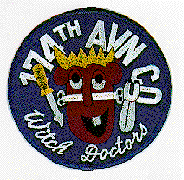
Our mission was to orbit the operation and to land near any downed ship as quickly as possible. Retrieving the crew was the top priority. If we could make some quick repairs to the ship so it could be flown out or lifted out, fine; but that was clearly a lower priority. The battalion MO had determined there would be
two high birds, flown by himself and another Captain, and that I (a Lieutenant) would fly the low bird.
We launched about 15 minutes before the main flight. Lt. Richard Gabauer was the copilot on my helicopter. He was from one of the Dolphin slick platoons and was assigned to fly with me for the day. SP4 Dave Smalley was the CE (crew chief), SP4 Harold Brasket was the gunner, and SP4 Jim Watkins, SP4 Mike (Mac) McFadden, and SP4 Rumaldo Salinas were our maintenance specialists.
Elliott and Smalley had the most time in country, with Smalley having only one
month left before rotating back to the States. Brasket and Gebauer had been in-country less than 30 days.
Elliott recalls: |
We were just west of A Luoi when we were hit by .51 cal fire. At least one round hit the engine, and it quit. I got off a MAYDAY call that you can hear on the recording (a recording of the cockpit and radio calls that Don Peterson made from another Dolphin helicopter that day). I executed a low level crash landing into the trees, letting the tail boom take the brunt of the crash. No one was hurt. Everyone got out without trouble. One of the M-60’s (door gunner’s machine gun) was pinned against a tree, but we removed the other 60 and some ammo. We only had one survival radio, our individual weapons, and our individual canteens. There was no food on the ship.
on the player icon to hear Butch's Mayday call.
We saw some NVA (North Vietnamese Army soldiers) coming toward us, so we moved off about 200 yards. We knew the NVA would have no trouble finding our ship, so there was no point in staying near it. Before we left, I had Rich Gebauer shoot the radio equipment (to destroy it and keep the enemy from using it), especially the KY-28 secure radio.
We came to an abandoned NVA .51 cal pit that we thought we could defend, and we set up there. The pit was shaped like a donut. It did not have any overhead cover, so we could see the aircraft that worked with us (trying to rescue us), and they could see us. We were shot down about mid-morning. I talked to Maj. Dale Spratt (our Company Commander) on the survival radio so they knew that we were OK, and about where we were. I know Maj. Spratt attempted to get in to get us, but he took too much anti-aircraft fire and was forced away.
Spratt remembered this was one of his many aircraft to be shot down, with two Shark gunships being shot down on the March 3rd going into LZ LOLO, and one Dolphin slick being lost with SP4 Gary Padilla dying in the aircraft. In fact, from March 3rd to the 5th, four UH-1C Shark gunships and two UH-1H Dolphin slicks would be lost from the 174th.
There were several early attempts to rescue the Witch Doctor crew, but the
enemy fire was so intense from all sides that the efforts had to be stopped. Elliott and his crew remembered how startled they were when fire broke out from all sides of them as the rescue helicopters attempted their approach.
An Air Force "Jolly Green Giant," whose jungle penetrator got to within ten feet over their heads, was forced to abandon the attempt because of the heavy fire. The enemy ground fire was so intense that one of the “Sandy” A-1 Skyraiders was shot down. Fortunately, the USAF Jolly Green helicopter was able to get that pilot out.
The Air Force coordinated the air cover over the Witch Doctor crew, with FAC’s (forward air controllers) flying OV-10 Bronco’s, stationed in Thailand, from two units with the call signs “Hammer” and “Nails.” The Hammer’s theme song was, “I would rather be a Hammer than a Nail."
On the ground: |
The crew made initial contact with the USAF FAC, Hammer 55, Captain John Wright, who reported eight flight levels of fighters from the Air Force, the Navy and the Marines, who were holding high and ready to protect the downed crew. “They would be our saviors,” said Lt. Elliott.
Elliott continues: |
It wasn't long after that, that we called in our first of 97 air strikes as the NVA would threaten us. We figured out where a stream was and tried to move to it. There were just too many active NVA anti-aircraft positions between us and the stream, so we gave that idea up.
While we were doing this, we discovered a pipeline carrying fuel, and
reported this to the FAC. Later in the day, he told us that he would be "out
of the area for awhile," and we didn't understand why. Soon the ground began
to shake and limbs fell off the trees. We determined that he had to move
away while the B-52 strike was put in about a mile from us.
That evening we received a pretty serious ground probe from the NVA, that in retrospect was probably intended for us to use up our ammo. My most vivid memory of that evening is the "pop" sound of the spoon on a grenade flying toward us, then bouncing off the trunk of a tree in front of us, and exploding on the other side of the tree.
Thank God for the U.S. Air Force AC-130A “Spectre” gunships. They were night vision equipped and would fire within 20 to 30 FEET of our position. The NVA quickly learned that any serious threat against us was quickly met with an air strike during daylight hours and Specter during the night.
The 14th Combat Aviation Battalion's ORLL reported: |
There was a total effort to extract Lt. Elliott and crew, but enemy fire prevented Air-Sea Rescue from extracting the downed crew. The crew of Witch Doctor 5 from the 174th AHC spent their second day on the ground west of A Luoi.
Butch Elliott continues: |
As mentioned previously, we put in a total of 97 air strikes during our "visit
to Laos." The USAF FAC reported that, at one time, he had eight sets of
bombers stacked up waiting to put their loads in around us. Only once did
they scare us. When the FAC talked to his jets, he would have to tune his
radio to their frequency and couldn't talk to us. A Thai team put a load of CBU (cluster bomb units)
in very close, and we couldn't tell him just how close it was. Our gunner was
hit in the arm from some of the shrapnel.
Another strange thing happened on this day. A lone NVA soldier happened along, and I shot him with my 38 pistol. I then crawled over to get his canteen because we really needed the water. When I returned to our pit, we discovered that the canteen was mostly empty. It had one bullet hole in it with the bullet still inside. I looked toward the NVA soldier I had "killed" and he was gone! A friend of mine still has the canteen.
BG Sid Berry flew over us that morning and said they had a plan for "one more thing" to get us out, but after that we were on our own. Naturally, we understood there is only so much anyone can do, but those were pretty scary words. For security reasons he didn't tell us what they planned to do. It involved inserting the HAC BAO company about a mile southeast of us that afternoon. The Hac Bao were the Black Tiger troops of the 1st ARVN Inf Div that would recover downed US crews in Laos.
We weren't exactly sure what was going on at first. Then we could see what was obviously a combat insertion, and listened to almost continual fire fights as the ARVN (South Vietnamese soldiers) worked their way to us.
The FAC’s dropped resupply canisters to us. During the entire time, I think they dropped six canisters, which were really flare canisters packed with sponges to protect the water bottles and radios. We only got a little water this way. We were really fortunate that one of their radios worked because by the end of the
second day the batteries in the survival radio we had taken from the ship
were dead. That evening the NVA that passed by our position didn't seem to
be directly interested in us, but seemed to be falling back from the pressure
the HAC BAO put on them. We continued to use the Specter gunships that
evening.
March 7, 1971 |
The 101st Division's ORLL (Operational Readiness Leasons Learned) states that during the period 7-10 March, the forces
from LZ HOPE linked up with elements to the south on the escarpment. As
enemy pressure began to build in the Tchepone area, all elements withdrew
south of Route 9 and began moving toward SOPHIA WEST.
The 14th CAB's ORLL reported that Lt. Elliott and crew were extracted with negative injuries.
Butch Elliott, Witchdodctor 5, continues: |
I don't remember sleeping at all during those three days and two nights. We
were very much aware that the HAC BAO were getting close to us. We could talk to the FAC and he had a Vietnamese "backseater" who could talk to the HAC BAO. We had arranged a password--we were to call out "Witch Doctor" and they "HAC BAO." But they kept saying "A OK." We'd tell the FAC that they were not saying the correct words and to have his "backseater" get it right, but this never happened. It really didn't matter much, for we only had four rounds of ammo left when they got near us. If it hadn't have been them, we would have had to go with whoever it was anyway.
We linked up about 3 p.m. and moved back over the same terrain and trails they had taken to get to us. It took us about 3 hours. We passed concrete bunkers and some impressive NVA works. It was obvious that the NVA had "built to stay" in this area. I don't remember seeing any HAC BAO KIA’s, and I think I would have noticed if they had any. They were very good troops and certainly had our respect and appreciation--they saved our lives!
When we got to the PZ (pickup zone), all the trees had been cut and it was ready. Helicopters from A Troop 2/17 Cav performed the extraction.
Over the years, several people have claimed to have been my "rescue ship." We'd talk things over and their version of the story just didn't square with my memory. Then I met Frank Esposito from A Troop, 2d Squadron, 17th Cavalry, 101st Airborne Division, who remembered things just as I do.
At the 1992 Vietnam Helicopter Pilots Association (VHPA) reunion, I met Frank again, and I signed his DFC (Distinguished Flying Cross) orders that he got for rescuing me.
Return to the crash site with the FAC's: |
When we got back to our company, Dale (Maj. Spratt) grounded me. I was very interested in meeting the FAC’s that had done so much for us, so since I couldn't fly with my company, I hitched a ride down to DA Nag and went to meet them. By coincidence, one of them was returning to support the operation and asked if I wanted to go along in his USAF OV-19. I was very curious to see this area
again, so I went. He showed me our wreck and all the area around it. That
was really special, and it helped me understand what we had lived through during
those times.
Today |
Butch Elliott has maintained contact with everyone except Richard Gebauer and
Rumaldo Salinas, both of whom Butch has not been able to find.
He has found and contacted the following Hammer FAC’s:
Hammer 21: William Roger Carter
Hammer 86: Charles R. Hosmer
Hammer 55: John A. Wright
Hammer 59: William P. Applegate
Hammer 84: Thomas O. Flemming
Below are six photos of
the celebration party of
the “Witch Doctor’s” recovery, in the Maintainence Tent, Quang Tri, 7 March 1971 (photos courtesy
of the late "Shark 7", Fred Thompson):
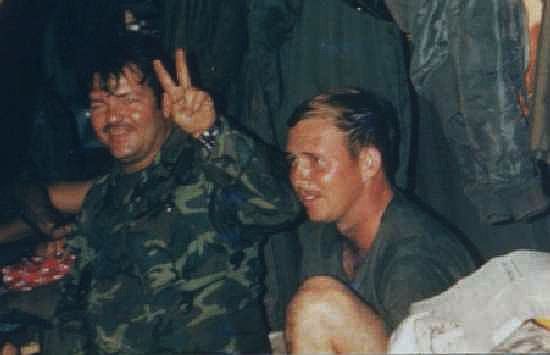
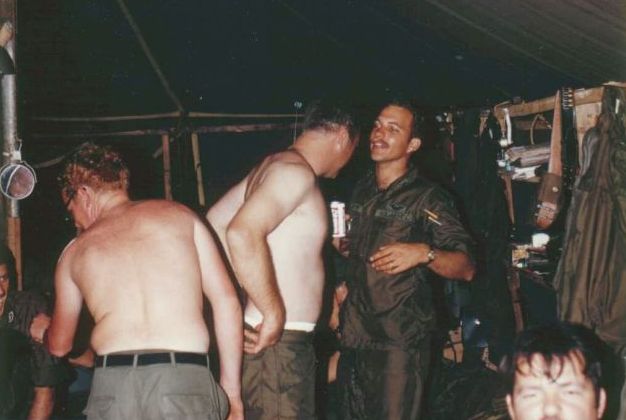
Above Left l-r: A "very drunk" SGT E-7 Ray
Richards and a "very tired" LT Butch Elliott.
Right l-r: SP4 Red Jones (Avionics), Dolphin WO1 Jim Story (see notes below), Shark 1LT Bob Hackett and SGT
Ray Richards.
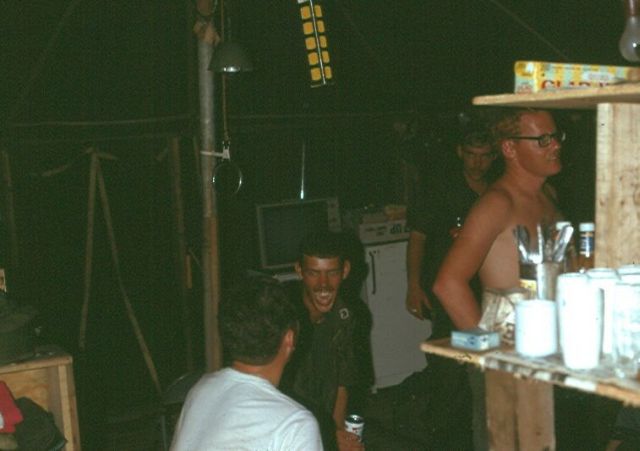
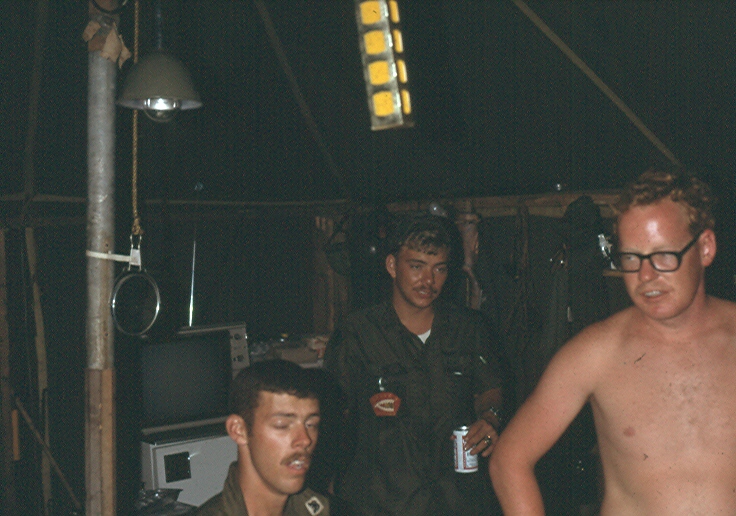
Both above photos are l-r: (Dolphin 19) Neal Varners, Shark WO1 Jim Souders and SP4 Red Jones (Avionics)

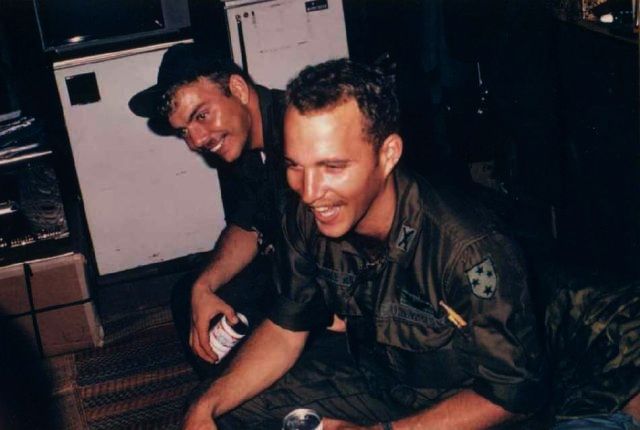
Above Right l-r: Shark 1LT Bob Hackett, SP4 Red Jones (Avionics) and Dolphin WO1 Jim Story. Above left: Shark WO1 Jim Souders and Shark 1LT Bob Hackett
5 March 1971: About 15 mins after “Witch Doctor
5” was shot down,
“Boats 29” (their call sign) Dolphin UH-1H 68-15215 was also shot down within a ”klick” of the
“Witch
Doctor 5” (west of the intended LZ). Already burning, it landed hard, leaning to the left, then rolled over and was engulfed in flames. Miraculously,
the Crew was extracted, but all ARVN troops on board perished. The AC was CPT Robert Johnson.
The Co-Pilot was WO1 Jim Story. The Crew Chief was SP4 Eddie Nichols and the Door Gunner was Lee Fairchild. For a short time, Pilots Johnson and Story were tangled up in their harnesses but escaped the burning aircraft.
Both Nichols and Fairchild had jumped from the helicopter before it hit the ground, to escape the flames. Fairchild was then pinned under the left side of the aircraft as it rolled over. To this day he doesn't know how he got out from underneath. Lee says:
"I found myself laying away from the wreck! Then I found CPT Johnson walking in a daze near the chopper. We both tried to rescue whoever was remaining inside. We could hear screams. The flames and the heat were too great. The ammunition was firing off and 'zinging' everywhere. There was no hope for whoever was still in there. I actually thought it was Nichols, but he was already on the 'rescue ship'". Dolphin 17 extracted all Crew members but Story, who couldn’t be found and
presumed dead in the burning wreckage. Story apparently found some ARVNs and confiscated a
PRC-25. He was later found “wondering” at the crash site
and extracted as well.
![]() Return to top of: This page.
Return to top of: This page.
![]() Return to top of: 1971 history page.
Return to top of: 1971 history page.
![]() Return to top of: Home Page.
Return to top of: Home Page.
